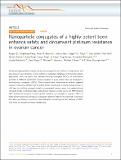Nanoparticle conjugates of a highly potent toxin enhance safety and circumvent platinum resistance in ovarian cancer
Author(s)
Lauffer, Sam; Matulonis, Ursula; Pepin, David; Birrer, Michael J.; Qi, Ruogu; Wang, Yongheng; Bruno, Peter Michael; Xiao, Haihua; Yu, Yingjie; Li, Ting; Chen, Qixian; Kang, Xiang; Song, Haiqin; Yang, Xi; Huang, Xing; Detappe, Alexandre; Hemann, Michael; Ghoroghchian, Paiman Peter; Wei, Wei, S.M. Massachusetts Institute of Technology. Department of Civil and Environmental Engineering; ... Show more Show less
Downloads41467-017-02390-7.pdf (1.786Mb)
PUBLISHER_POLICY
Publisher Policy
Article is made available in accordance with the publisher's policy and may be subject to US copyright law. Please refer to the publisher's site for terms of use.
Terms of use
Metadata
Show full item recordAbstract
Advanced-stage epithelial ovarian cancers are amongst the most difficult to treat tumors and have proven to be refractory to most cytotoxic, molecularly targeted, or immunotherapeutic approaches. Here, we report that nanoparticle-drug conjugates (NDCs) of monomethyl auristatin E (MMAE) significantly increase loading on a per-vehicle basis as compared to antibody-drug conjugates (ADCs). Their intraperitoneal administration enabled triggered release of the active MMAE toxin to inhibit tumor growth and to extend animal survival to > 90 days in a cell-line xenograft model of disseminated ovarian cancer. In a patient-derived xenograft model of advanced-stage and platinum-resistant ovarian cancer, an MMAE-based NDC doubled the duration of tumor growth inhibition as compared to cisplatin. NDCs of highly potent toxins thus introduce a translatable platform that may be exploited to maximize the safety and efficacy of cytotoxic chemotherapies, combining the best features of ADCs with those of nanoparticle-based therapeutics.
Date issued
2017-12Department
Koch Institute for Integrative Cancer Research at MITJournal
Nature Communications
Publisher
Nature Publishing Group
Citation
Qi, Ruogu et al. “Nanoparticle Conjugates of a Highly Potent Toxin Enhance Safety and Circumvent Platinum Resistance in Ovarian Cancer.” Nature Communications 8, 1 (December 2017): 2166 © 2017 The Author(s)
Version: Final published version
ISSN
2041-1723